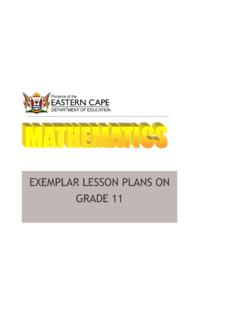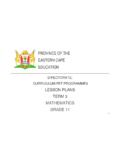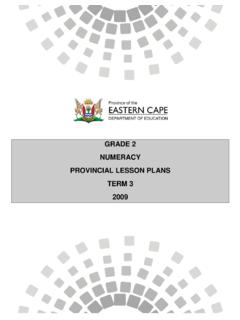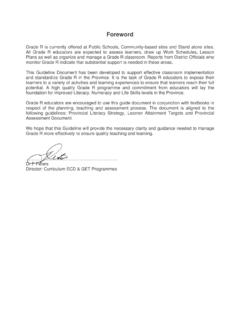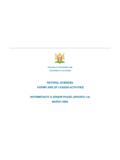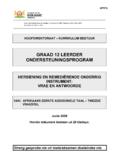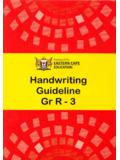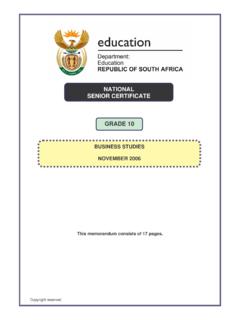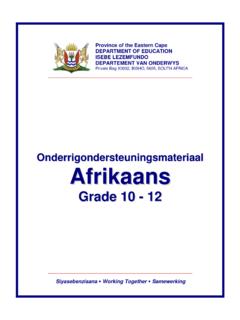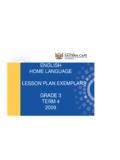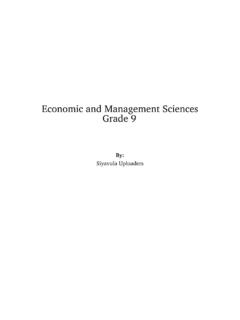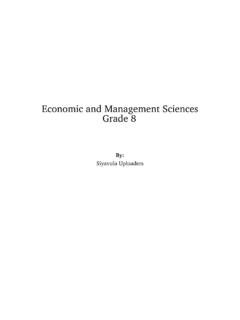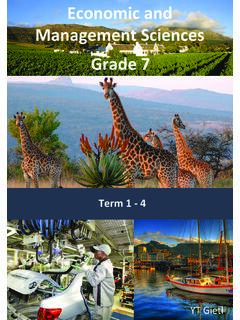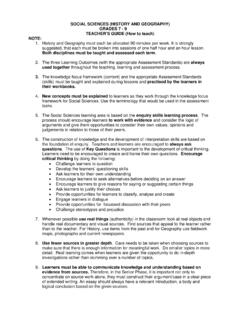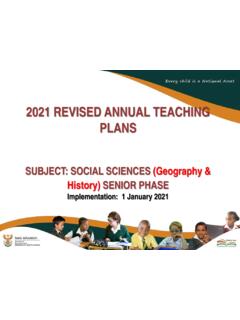Transcription of Term 1 Lesson Plans - Curriculum
1 53 54 grade 6 Lesson PLAN 2 TERM 1 Learning Area: economic and management sciences Context: Duration: 4 Weeks (8 HRS) Date completed: SKILLS Discussion Comparing Describe Identify Listening Present KNOWLEDGE AS 3: Concepts: Resources Services Flow of wages to households in exchange for labour Flow of money to business in exchange for goods & services Different flows of resources and services in the economic cycle AS 4: Concepts: Taxes Direct tax personal tax, company tax Indirect tax VAT and sin tax Property tax Income tax Types of taxes and how they influence consumers and businesses VALUES Respect Honesty Responsibility Rights LO 1: THE economic CYCLE AS 3.
2 Presents different flows of resources and services in the economic cycle ( the flow of wages to households in exchange for labour, the flow of money to business in exchange for goods and services AS 4: Explains the different types of taxes and how they influence consumers and businesses 55 Activity 1(a) The teacher further explains the concept of the economic cycle: The flow of goods and services and income/wages affects the households, the government and the business because they all buy and sell from one another. Households buy goods and services from the government and businesses and sell their labour to these sectors.)
3 Since buyers are sellers and sellers, there is a continual flow of spending between them. This flow never ends and is called an economic cycle. The teacher recalls the role of households, business and the government to indirectly introduce the learners to the economic cycle. He either draws lines or uses a blank circular flow diagram, Annexure A to illustrate the flow of money to the business in exchange for goods and services. He uses the same diagram /lines to illustrate the flow of wages to households in exchange for labour. Activity 1(b) The teacher engages the learners in a role play. He writes the different role players on the board.
4 He then asks the learners to form groups of three. Each learner in the group will represent one of the three parties in the economic cycle (household, business, government). He gives the learners the following instruction: After each instruction the responsible party must ass his/her line in the economic cycle. provide labour to the government and business Business ..please pay Households for the labour /he has provided you Learners continue like this until all lines have been drawn, Annexure B inset module for guidance Learners are given the following case study to demonstrate that they can apply their acquired knowledge.
5 FORMAL TASK James October works at food canning factory. The government sells water and electricity to the factory He sells his labour to the factory for a salary. Farmers sell vegetables and fruit for canning to the factory. The factory sells its canned fruit and vegetables to shops. The shops sell the canned fruit and vegetables to the households. The teacher marks the learner s work and then provides feedback. Assessment: Form: Class work , CASE STUDY, Tool: Method: Educator Activity 2(a) As prior knowledge the teacher asks the learners to answer the following question: Define the concept, tax Differentiate between direct and indirect tax 56 List the different types of taxes The teacher briefly explains the different types of taxes.
6 Customs duty payable on imports PAYE Paid by each employer calculated on the individual s total income Stamp duty payable on banking transactions, registration of transfer , cancellation or redemption of shares Road tax for each litre of petrol sold, some money is paid in tax VAT paid on almost everything that is sold. VAT rate is currently 14% There are food items that are VAT free, bread, milk, mealie meal, fruit and vegetable Import tax paid on goods bought from other countries Fuel tax included in the price of petrol, paraffin, diesel Estate levied on the net value of a person s estate upon his death Excise tax included in the price of cigarettes, alcoholic beverages, cool drinks, tobacco, etc.
7 Municipal tax levied by municipalities, paid by property owners for sewage, rubbish removal, water and electricity Sin tax- The government makes us pay a lot of indirect tax for products they do not want us to buy cigarettes and beer The teacher asks the learners to differentiate between direct and indirect tax using the following table: Learners are given the following exercise to complete: What kind of tax do these people have to pay a) Tozie s aunt bought a machine from Germany for her business b) Mr. Themane buys 10 litres of paraffin a month for his stove 57 c) Julie s mother works in a supermarket.
8 She pays R500 tax a month d) Andile bought a new shirt which costs120 e) Kobus has noticed that cigarettes now cost 30 cents more per packet f) Themba has inherited a house worth R2million He instructs the learners to exchange their books for marking and then do corrections. Activity 2(b) The teacher tells the learners that when consumers and businesses pay tax, it is always good for the government because it means they are getting revenue. Sometimes the government discourages the consumers from buying certain items. He then gives learners an exercise to identify the type of tax and explain its influence ,Annexure C The teacher marks the learner s work and provides a feedback Assessment: Form: Class work , Tool: Memo, Method: Educator 58 ANNEXURE A 59 ANNEXURE B 60 ANNEXURE C 61 SENIOR PHASE 62 OVERVIEW grade 7 TERM 1 TERM 2 TERM 3 TERM 4 LEARNING OUTCOMES AND ASSESSMENT STANDARDS LEARNING OUTCOMES AND ASSESSMENT STANDARDS LEARNING OUTCOMES AND ASSESSMENT STANDARDS LEARNING OUTCOMES AND ASSESSMENT STANDARDS LO 1 : economic CYCLE CLUSTER 1 AS 1.
9 Explain needs and wants and how the differences between them impact on communities and the environment AS 2: Describes the different types of businesses and activities within the primary, secondary and tertiary sectors AS 3: Explains the concepts free and economic (scarce) goods, and the influence of demand and supply on market prices LO 4: ENTREPRENEURIAL KNOWLEDGE AND SKILLS CLUSTER 1 AS 1: Compares essential characteristics and skill needed to be entrepreneurial from two simple case studies of practicing entrepreneurs in own community AS 3: Participates in a joint venture between the school and the community/pa rents by taking ownership of producing a product or service LO 3: management , CONSUMER AND FINANCIAL KNOWLEDGE AND SKILLS CLUSTER 1 AS 1: Explains the role of planning, organizing, leading and controlling ( financial and procedural controls) in a business.
10 AS 2: Discusses different approaches to leadership and management AS 5: Draws up an elementary statement of net worth, using personal record LO 3: management , CONSUMER AND FINANCIAL KNOWLEDGE AND SKILLS CLUSTER 1 AS 7: Explains the different processes of human resource management CONTENT CONTENT CONTENT CONTENT AS 1: Concepts: Needs and wants Characteristics and differences How the difference between needs and wants impact on communities and environment AS 1: Concepts: Characteristics vision, responsibility, taking risks, enthusiastic, confidence , determination etc Skills solve problems, decision making, planning and organizing etc AS 1: Concepts: Planning Organizing Leading Controlling (financial and procedural control AS 7: Concepts: Human resource management Planning Recruitment Selection Induction Placement 63 AS 2: Concepts: Different types of businesses and activities Primary Secondary Tertiary AS 3: Concepts.)
